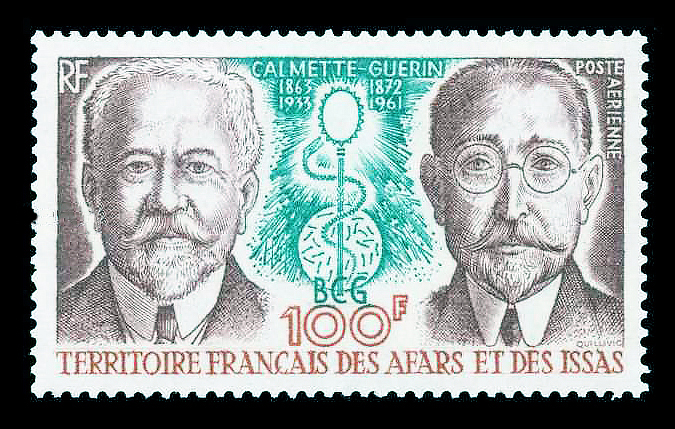Calmette & Guerin (Afars and Issas)
The stamp
This stamp shows Albert Calmette and Camille Guérin. It was issued in the French territory of the Afars and the Issas in 1972. Previously known as French Somaliland, this territory is now Djibouti.

The doctors
Jean-Marie Camille Guérin (1872 to 1961)
Jean-Marie Camille Guérin was born in Poitiers on 22 December 1872. He studied to become a vet but, in 1897, he joined the Institut Pasteur de Lille and worked with its director, French physician, bacteriologist and immunologist Albert Calmette.
He was promoted to Head of Laboratory in 1900 and devoted himself, with Calmette, to research on a vaccine against tuberculosis. In 1905, he discovered that the bovine (cow) tuberculosis bacillum could be used to immunise animals without causing the disease. In 1908, they made an immunologically active preparation that could be used to create a vaccine and he published, with Calmette, the results of what came to be called BCG.
Albert Calmette (1863 to 1933)
Léon Charles Albert Calmette was born in Nice, France on 12 July 1863. He joined the French Navy as a doctor in 1881. He travelled a lot serving in Japan, North America and Africa. When he returned to France in 1890, he worked with Louis Pasteur at the Pasteur Institute in Paris. He was sent to French Indochina to set up a branch of the Pasteur Institute in Saigon. Back in France again in 1895, he was put in charge of the Pasteur Institute in Lille. He was very interested in infections, especially tropical diseases. He studied malaria and sleeping sickness, and developed anti-venom against snake bite.
The urology connections
With Albert Calmette, he helped develop the BCG (Bacillus Calmette Guerin) vaccine against tuberculosis (TB). In urology, BCG is used to treat some forms of bladder cancer. Put into the bladder, iyt can reduce the chance of the cancer coming back or getting worse.
Calmette also studied filariasis (or elephantiasis) and wrote his medical thesis on it. Filariasis can cause huge swelling of the body, so the person looks almost like an elephant. We sometimes see this in urology, affecting the legs and scrotum.
← Back to Stamp Collection